AI in B2B SaaS
In B2B SaaS, two concepts have been making waves: Vertical SaaS and AI. There's no denying the potential that lies at the intersection of these two trends. In this article, we will explore the reasons behind this synergy and why this is so promising. We will also explore the relatively uncharted waters of AI in Horizontal SaaS, a territory often dismissed due to the dominance of incumbents and platform risks.
Vertical vs. Horizontal SaaS
It's essential first to understand the distinction between Vertical and Horizontal SaaS. Vertical SaaS is specialized software tailored to a specific industry, whereas Horizontal SaaS offers a broader set of functionalities applicable across various industries.
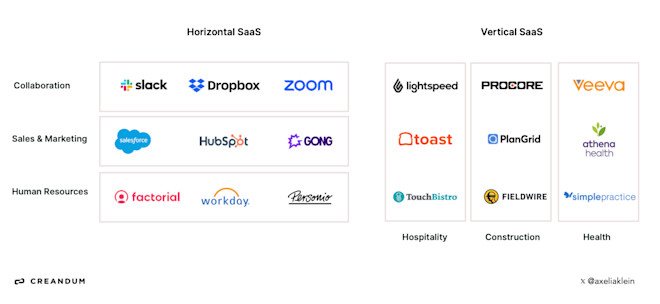
Horizontal vs. Vertical SaaS
The Excitement Around Vertical SaaS
Vertical SaaS companies customize their offerings to solve sector-specific challenges. This deep understanding of the industry nuances, regulatory landscapes, and targeted problem-solving capability often translates into a strong, vertically integrated value proposition, increasing switching costs and reducing customer churn.
Vertical SaaS companies have gained a lot of attention for many good reasons:
Leveraging industry-specific data: Vertical SaaS gains a competitive edge by accessing and fine-tuning models on proprietary datasets which creates a barrier against potential competitors
Deep Domain Expertise: Models are tuned for specific use cases, while the leadership team possesses an intimate understanding of the customers which results in a superior product experience, often exceeding expectations.
Market Penetration Potential: Vertical markets often have low penetration levels. With AI as a catalyst, businesses can establish a substantial presence in these untapped territories.
Low Customer Acquisition Costs (CAC): Targeted marketing in Vertical SaaS keeps CAC low, allowing newcomers to compete effectively against incumbents bundling products.
The resulting opportunity to gain market share by delivering a 10x improvement where previously incremental innovation was the norm has led to an explosion of AI-first companies across a number of categories within vertical SaaS.
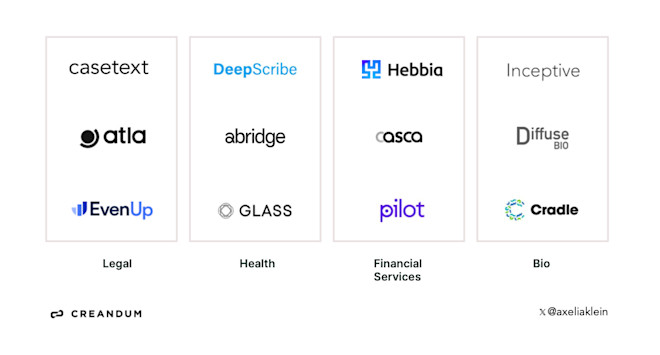
Examples of B2B Vertical AI companies
What about Horizontal SaaS?
Horizontal SaaS has received less attention. The prevailing argument suggests that incumbents control both data and distribution channels, while access to Large Language Models (LLMs) is both commoditized and with platform risks. An opportunity for horizontal software is mainly seen in middleware and infrastructure, which allow for developer-led customization and can be altered to cater to specific use cases.
Compared to the shift to the cloud, which yielded a vast number of category-defining companies, existing horizontal SaaS players have been quick to adopt this technology while leveraging existing customer data. As Christoph Janz emphasised previously, in contrast to the shift from on-prem to cloud, adding generative AI features to your product does not require a complete rebuild but in many cases just calling some open APIs. A case in point are companies like Intercom, Hubspot, or Zendesk - all horizontal SaaS companies that demonstrated how rapidly existing players can adapt and implement LLMs.
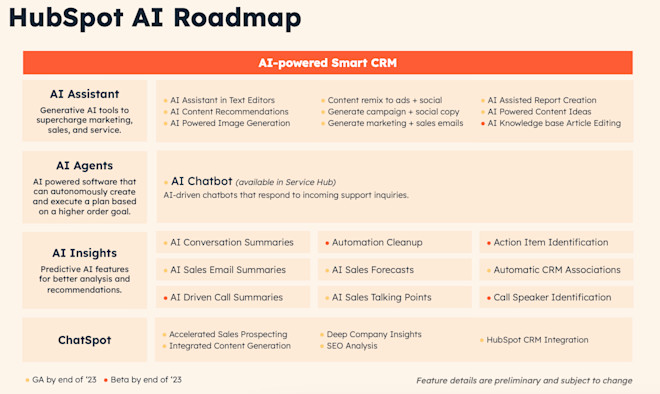
Hubspot AI features
End of story?
LLMs have enabled a fundamental shift in the way companies interface with software. From a first principles perspective, what really is a SaaS application? It's data and workflows. Now, with chat-based interfaces and agents, the way users interact with data and how these workflows are carried out is changing fundamentally. This is leading to the emergence of software categories where the dominant feature will be AI, with companies wowing users from the get-go by delivering a previously unthinkable product experience. With that shift, new opportunities in horizontal software emerge.
We are convinced the story doesn't end there.
AI-First Interface: Startups can leverage AI to build products that captivate users from the outset. New technology enables novel interfaces. Potentially comparable to the shift from the command line -> graphical user interfaces (GUIs) -> mobile, and how a new technology introduced software with a look and feel which is vastly different than before
Adaptability vs. Legacy: As companies grow, they tend to lose agility and the ability to pivot swiftly. This opens the door for startups to replace legacy companies in established industries. While existing scale-ups, such as an Intercom, can adapt rapidly and implement LLMs, the same isn’t necessarily true if you are replacing software that has been around for 10+ years
Data Ingestion: Historically, data ingestion has been a substantial challenge in selling to enterprises, but recent advancements have reduced switching costs.
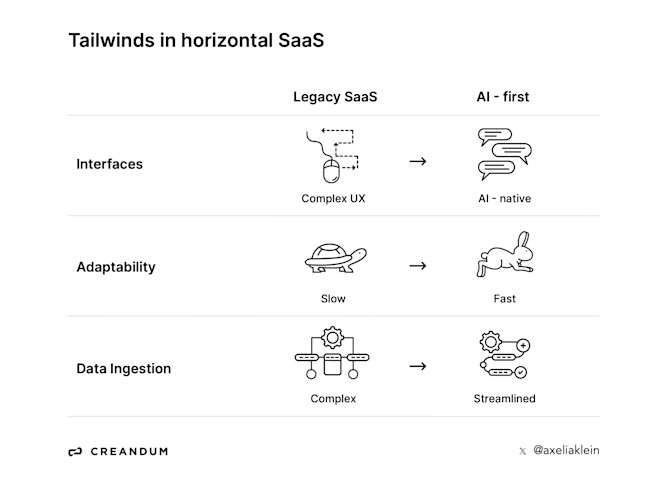
Tailwinds in horizontal SaaS
What can we learn from previous platform shifts?
AI first UI / UX / Innovation
Although already seemingly ancient history, a comparison to the transition from command-line interfaces (CLIs) to graphical user interfaces (GUIs) might not be too far-fetched. Prior to GUIs, interactions with computers required a deeper understanding of command-line syntax, which was often intimidating for the average user. GUIs introduced visually intuitive elements like windows, icons and menus, which allowed users to engage with software in a more instinctual, point-and-click manner. This newfound ease of use stimulated a massive demand for user-friendly software applications, leading to an explosion of new software products and startups.
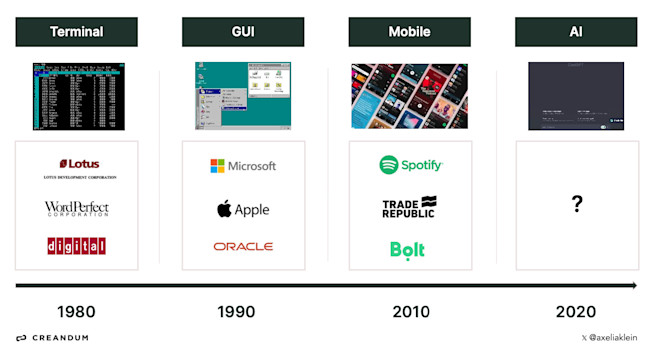
Previous UI / UX shifts
We might now be seeing a return to the purest form of human-machine interaction. But instead of lines of code, the input has changed to natural language. Where earlier AI interactions often required specialized knowledge or specific input formats, LLMs offer a more natural, conversational mode of engagement. Users can communicate with these advanced models in plain language, much like they would with another human, eliminating the steep learning curve previously associated with AI.
Looking ahead, the jury is still out on whether prompting will remain the primary way to interface with LLMs. Prompting might be replaced by other 'in context' interfaces, each adopting or adapting to the specific use case. Either way, we believe new horizontal products can emerge that enable a 10x better UX/UI experience, by redefining what interaction between data and users looks like.
Adaptability vs. legacy
As we witnessed in the transition from on-prem to cloud, incumbents are often subject to decades of ingrained processes, deep-rooted systems, and a culture resistant to change. This gave a strategic advantage to agile startups, which, unburdened by legacy infrastructure, were able to capitalize on the cloud's scalability, cost-efficiency and global reach to deliver innovative solutions that led to the creation of generational companies such as ServiceNow, Twilio, or Atlassian.
As mentioned, established companies like Hubspot or Zendesk have been quick to adopt AI. In enterprise specifically, however, customers are still often serviced by legacy incumbents that are facing sunk cost fallacy and potential innovators dilemmas. Although less prevalent than during previous platform shifts, we still see potential gaps in the market opening up for startups to capitalize on the organizational inertia of incumbents particularly in enterprise software.
Data ingestion
Over the past years, data ingestion in enterprise software has seen remarkable improvements thanks to several converging factors. Advanced integration platforms and tools have become more prevalent, offering plug-and-play solutions for data migration. Enhanced APIs and standardized data formats promote smoother data exchange between disparate systems.
With new advancements in AI it is now also significantly easier to take unstructured data that sits in PDFs or other static formats and turn them into structured data. This evolution has a direct impact on reducing switching costs for enterprises. Whereas in previous platform shifts, data ingestion and migration were cumbersome and served as a substantial moat for incumbents, suddenly companies can find it easier to transition between software solutions without the fear of data loss or extensive downtimes.
Changing Landscape in Enterprise
New AI startups have the unique chance to captivate users from the get-go by redefining user interaction. Much like previous seismic shifts such as command line to graphical user interfaces (GUIs) or the emergence of mobile, AI is unlocking new opportunities in both vertical and horizontal SaaS. This is fueled by the organizational inertia of incumbents and reduced switching costs due to improved data migration and ingestion infrastructure.
Horizontal SaaS typically addresses expansive markets, offering opportunities to build substantial companies. While the barriers may seem formidable, the potential rewards are equally great. We are already seeing a glimpse of what the next generation of horizontal software might look like with companies such as Beam AI, induced, or Adept reimagining the interplay of workflows, data, and users - regardless of vertical.
The LLM (r)evolution is a substantial pivot towards a more efficient, innovative and competitive market space. For startups, this is nothing short of a clarion call to action, as we are convinced that the market is ripe for the taking.
Category-defining companies
At Creandum, we look for products and solutions capable of delivering a 10x better experience. Vertical AI undoubtedly holds the promise of deeper market penetration in underserved industries. However, we also firmly believe in taking bold bets that can topple the giants of the software world and give rise to a new generation of category defining companies.
Co-authored by Beata Klein and Richard Keuntje.
If you are a company building in this space and want to chat let us know!
References:
Generative AI: An Asteroid Impact Event on B2B Software - Christoph Janz
Will AI Accelerate Vertical SaaS Adoption? - Christoph Janz
Second-order effects of AI in Vertical SaaS- Akash Bajwa
Product-Led AI - Seth Rosenberg
AI is Reinventing the Legal Industry - Morgan Beller and James Currier
Vertical AI: The next logical iteration of vertical SaaS - Paris Heymann
Horizontal vs. vertical AI - Krishna Nadakumar
10 Lessons from a decade of vertical software investing - Brian Feinstein and Caty Rea
Is AI generation the next platform shift - Bhavik Nagda, Lucy Pless and Talia Goldberg
Vertical(ai) is the new horizontal - Rajeev Dham, Jason Brooke and Andrew Vogeley
